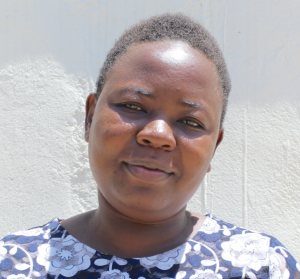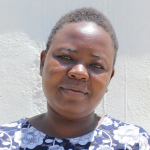The 859 students and staff of Mungulu Primary School struggle to access sufficient water to meet their daily needs.
"The school has one rain harvesting tank with a capacity of thirty thousand liters which serves them only during the rainy season. The rain harvesting tank is located within the school compound, and the environment around [the] tank is not clean. The drainage is blocked, the gutters are not clean, and the tank has never been cleaned since implementation. That is [a] clear indication that the water is not clean," said field officer Betty Muhongo.
When the rain tank is empty much of the year, the students are responsible for finding water in other places, so they spend a significant amount of their day searching for and collecting water instead of being in class learning.

Students often stop off at local springs or streams on their way to school, but carrying heavy water containers and school bags exhausts them before their learning day begins.
"Carrying water every morning together with my school books has not been easy. At times, I get to school when my uniform is completely wet. Other times, I am forced to queue at the crowded water point, and by so doing, I get to school late and get punished for being late," shared 13-year-old Stellahmarn L., shown below at a community spring.

"Pupils normally bring water from home every morning as they come to school, but there are times when they are forced to stop their classes to go and get water. By so doing, the academic program is interfered with, thus leading to poor performance," said Betty.
"During dry seasons, pupils have to bring water to school, which has been a big channel for contracting waterborne diseases and hampering their health," Betty continued.
"The water in all these water points is not safe for human consumption unless treated or filtered. The teacher in charge of sanitation reports stomach ache problems combined with numerous diarrhea cases. The affected students or teachers have to get medication, which has cost them school time and [has] been one of the leading factors in poor performance and incomplete syllabus coverage."

"Since I am a parent too, I'm not happy when I see pupils being asked to get out of class to get water for general school usage. It usually averages to the entire afternoon or midmorning class hours lost and sends us a step back in coverage of the curriculum. I at once lost half of my class to an infection from dirty water, and it cost us very important time just before the exams," said 45-year-old teacher Stephen Mayende, shown above with his class.
"Drilling a borehole will be the best solution for this school because the issues of seasonality will be solved, and having a central water point that can be monitored will go a long way in preventing contamination of the water," concluded Betty.
Installing the well will enable students like Stellahmarn to return to class so she can learn and teachers like Stephen to focus on giving students learning opportunities to empower them for the future.
Water at schools is unique, which is why we need unique solutions.
The Proposed Solution, Determined Together...
At The Water Project, everyone has a part in conversations and solutions. We operate in transparency, believing it benefits everyone. We expect reliability from one another as well as our water solutions. Everyone involved makes this possible through hard work and dedication.
In a joint discovery process, community members determine their most advantageous water solution alongside our technical experts. Read more specifics about this solution on the What We're Building tab of this project page. Then, community members lend their support by collecting needed construction materials (sometimes for months ahead of time!), providing labor alongside our artisans, sheltering and feeding the builders, and supplying additional resources.
Water Access for Everyone
This water project is one piece in a large puzzle. In Kenya, Sierra Leone, and Uganda, we're working toward complete coverage of reliable, maintained water sources that guarantee public access now and in the future within a 30-minute round trip for each community, household, school, and health center. One day, we hope to report that this has been achieved!
Training on Health, Hygiene & More
With the community's input, we've identified topics where training will increase positive health outcomes at personal, household, and community levels. We'll coordinate with them to find the best training date. Some examples of what we train communities on are:
- Improved hygiene, health, and sanitation habits
- Safe water handling, storage & treatment
- Disease prevention and proper handwashing
- Income-generation
- Community leadership, governance, & election of a water committee
- Operation and maintenance of the water point
Handwashing Stations
Alongside each water source, we also provide two new gravity-fed handwashing stations that will allow everyone at the school to wash their hands without running water. Handwashing is so important to help prevent future water-related illnesses in the school community.
The student health club will maintain the stations, fill them with water, and supply them with soap (which we will teach the school community how to make during the training!).
VIP Latrines
In addition, we will construct two triple-door Ventilated Improved Pit (VIP) latrine blocks designed to prevent fecal disease transmission. Each latrine will have a cement floor, which is easy to use and clean regularly. Three doors will serve the girls, and three doors will serve the boys.

 Borehole Well and Hand Pump
Borehole Well and Hand Pump
 Rehabilitation Project
Rehabilitation Project



































